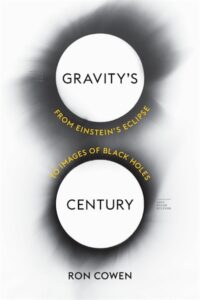 29 May 1919 – teams of scientists in Brazil and on the west coast of Africa observed and documented the positions of stars during a total solar eclipse, the results of which when analyzed confirmed Einstein’s recently published theory of general relativity.
29 May 1919 – teams of scientists in Brazil and on the west coast of Africa observed and documented the positions of stars during a total solar eclipse, the results of which when analyzed confirmed Einstein’s recently published theory of general relativity.
11 April 2017, a different team of scientists (those of the first team having long since retired, both professionally and existentially) completed five days of networked radio-telescopic observations of the event horizon of a black hole.
In his recently published Gravity’s Century; From Einstein’s Eclipse to Images of Black Holes, Ron Cowan explores, in language that is clear and readily intelligible to the non-specialist, the significance of the events that took place on these two dates, how researchers over the decades arrived at those of the the latter from the former, and what these discoveries about gravity and other forces at work in the universe, as well as those made during the intervening century, mean to us all for the future.
And, for any thinking “this certainly sounds interesting, but I’m not sure if I’m fully up to swimming in the deep end of the physics pool,” Mr. Cowan recently gave an interview to Ira Flatow for Science Friday – a podcast of which can be found here for the metaphorical dipping of an exploratory toe.
If you enjoyed reading this, please consider signing up for The Well-read Naturalist's newsletter. You'll receive a helpful list of recently published reviews, short essays, and notes about books in your e-mail inbox once each fortnight.
